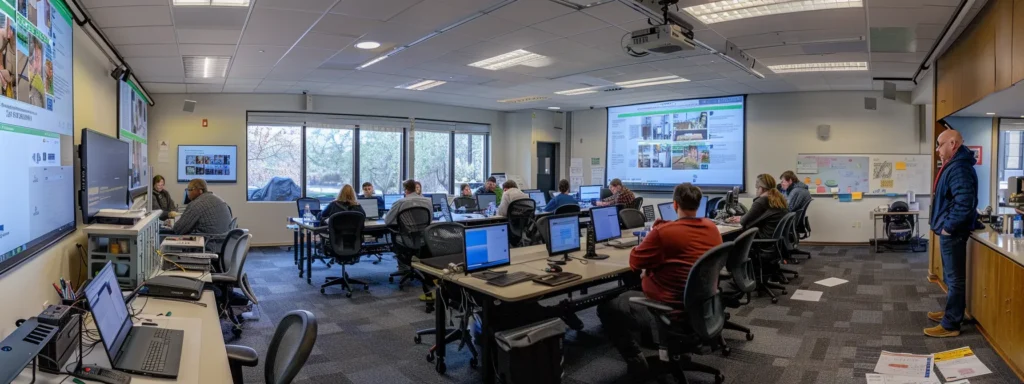Title: Efficient Strategies for CMS Technical Issue Resolution **Introduction** Are you struggling with persistent technical issues on your CMS? A recent survey found that over 60% of small business owners encounter difficulties with server-related problems impacting their online presence. This post will explore efficient strategies for troubleshooting common CMS issues, implementing preventive maintenance practices, and optimizing your CMS settings for improved performance. By engaging with this content, readers will learn practical solutions to common pain points, ensuring smoother content creation and management processes for their gov website or business platform.
Key Takeaways
- Regular updates to CMS software are essential for optimal performance and security
- Monitoring system performance helps identify potential issues before they escalate
- Routine site audits can pinpoint malfunctions and enhance user experience
- Utilizing error logs aids in diagnosing and resolving technical challenges effectively
- Establishing clear protocols empowers teams to respond swiftly to technical problems
Understanding CMS Technical Issues

Common problems in content management systems (CMS) can significantly impact website operations. This section covers how to identify issues such as broken permalinks, signs of phishing attempts, and general malfunctions in web pages. Additionally, it emphasizes assessing these Free SEO Audit technical issues within the context of existing policies, providing practical insights essential for efficient resolution.
Identifying Common Problems in Content Management Systems
Content management systems (CMS) often encounter various technical issues that can disrupt website functionality. One common problem includes broken permalinks that can frustrate users and hinder search engine optimization. Additionally, users may need to report inappropriate content or phishing attempts that compromise site integrity, necessitating swift action to safeguard data and maintain trust.
Debugging is a crucial aspect of identifying issues within a CMS. Users frequently face challenges related to plugins and themes that may not integrate well with the core system. This lack of compatibility can result in website malfunctions, prompting businesses to periodically assess their cloud computing infrastructure to ensure optimal performance, especially during high-demand periods associated with remote work.
Monitoring RSS feeds can also reveal hidden technical issues such as broken links or outdated information that detracts from user experience. Regular audits can help pinpoint any discrepancies, allowing site managers to address them proactively. By adopting a systematic approach to identify and resolve these common CMS problems, local small businesses can enhance their online presence and ensure a seamless experience for their visitors.
Recognizing Signs of Technical Malfunctions
Recognizing signs of technical malfunctions within a content management system is essential for maintaining a smooth web design experience. Users may encounter slow loading times, a clear parameter that indicates underlying issues. These delays can frustrate visitors, leading to higher bounce rates and impacting overall site performance.
An unresponsive site or features that fail to function correctly are clear indicators of technical issues. For instance, if bookmarks or navigation menus do not behave as intended, it often points to deeper problems within the CMS. Addressing these malfunctions quickly can help mitigate risks associated with poor user experiences, ultimately enhancing client trust and engagement.
Routine site audits can help catch malfunctions before they escalate into larger problems. Monitoring error messages or functionality discrepancies can serve as early warnings that indicate a need for intervention. By proactively managing these technical signs, local small businesses can ensure their content management systems function optimally, providing seamless user experiences that drive online success.
Assessing the Impact on Website Operations
Assessing the impact of technical issues on website operations is vital for local businesses using a CMS. Any disruption in the infrastructure, such as slow database queries or unresponsive features, can directly affect accessibility and user satisfaction. Identifying these issues enables businesses to mitigate risks and improve overall website performance, ensuring that visitors have a positive experience.
Furthermore, a thorough evaluation process helps determine how technical shortcomings hamper essential functions, such as content delivery and user interaction. For instance, if the CMS suffers from frequent downtime, potential customers may find it difficult to access important information, ultimately leading to lost revenue. Understanding these implications allows businesses to prioritize solutions tailored to their specific needs.
Effective strategies for resolving CMS technical issues should encompass ongoing assessments of website performance and user engagement metrics. By analyzing patterns in user behavior, businesses can proactively identify when technical problems arise, allowing them to maintain optimal functionality. This approach not only enhances site accessibility but also builds trust with users, contributing to stronger customer relationships and sustained online success.
Implementing Preventive Maintenance Practices

Keeping CMS software up to date, monitoring system performance regularly, and establishing reliable backup procedures are essential preventive maintenance practices. These strategies not only optimize website loading times but also enhance the effectiveness of Website Management Services. By implementing these measures, local businesses can safeguard their online presence while ensuring a seamless user experience, leading to improved trust and engagement.
Keeping CMS Software Up to Date
Keeping CMS software up to date is fundamental for ensuring optimal website performance and security. Regular updates from CMS providers typically include critical patches, new features, and enhancements that address known issues. By staying current, local businesses can improve site functionality and reduce potential vulnerabilities that may be exploited by malicious actors.
Establishing a routine for updating CMS software not only aids in the prevention of technical issues but also enhances user experience. For instance, updated software can improve loading times and site responsiveness, which directly contributes to higher user satisfaction and engagement. Businesses should prioritize this practice as part of their overall website management strategy to maintain a strong online presence and ensure smooth operations.
To implement an effective update strategy, local businesses can schedule regular checks for available software updates and create a checklist to streamline the process. By following a structured approach, they can avoid the risks associated with outdated systems:
- Prevent security vulnerabilities
- Enhance website performance
- Introduce new features and improvements
Monitoring System Performance Regularly
Regularly monitoring system performance is essential for local businesses to maintain optimal functionality within their content management systems (CMS). This proactive approach allows site managers to identify potential issues before they escalate into more significant problems, ensuring a seamless user experience. By keeping an eye on critical performance indicators, businesses can make informed decisions that enhance overall site performance.
Utilizing performance monitoring tools can streamline this process, enabling local businesses to track metrics such as page load times, server response rates, and error rates. For example, consistently slow loading times might indicate underlying technical problems that require troubleshooting. Implementing these tools ensures businesses remain aware of their CMS’s health, ultimately supporting enhanced user engagement and trust.
Establishing a regular schedule to review system performance metrics reinforces accountability and fosters a culture of maintenance within the organization. By incorporating this practice into the overall website management strategy, local businesses can avoid costly downtimes and improve user satisfaction. The key components of an effective system performance monitoring strategy include:
- Identifying critical performance metrics to monitor
- Implementing performance monitoring tools
- Scheduling regular performance reviews
Establishing Reliable Backup Procedures
Establishing reliable backup procedures is critical for local businesses using content management systems (CMS). Regular backups ensure that, in the event of a technical issue or data loss, vital site information can be restored quickly, minimizing downtime and maintaining website functionality. Businesses that prioritize this practice demonstrate a commitment to data security and user trust, which can significantly enhance their online reputation.
To implement effective backup procedures, local businesses should utilize automated backup solutions that run on a schedule, ensuring that the latest content and configurations are saved consistently. This eliminates the risk of human error and provides peace of mind, knowing that critical data is secured. Incorporating these automated processes helps businesses stay prepared for unexpected events, allowing them to recover swiftly and maintain operational continuity.
In addition to automated backups, businesses should test their backup restoration process regularly to ensure it functions correctly when needed. This proactive assessment can prevent potential challenges during an actual data recovery scenario, allowing businesses to verify that their backup systems are reliable and effective. By establishing and maintaining robust backup procedures, local businesses can safeguard their digital assets and focus on growth without the constant fear of losing valuable information.
Efficient Techniques for Resolving CMS Technical Issues

Efficient techniques for resolving CMS technical issues play a crucial role in maintaining website functionality. This section will cover diagnosing problems using error logs, applying step-by-step troubleshooting methods, and utilizing built-in CMS debugging tools. These strategies provide practical insights that local businesses can leverage to address technical concerns effectively and enhance their online presence.
Diagnosing Problems Using Error Logs
Diagnosing problems using error logs is an essential technique for local businesses aiming to troubleshoot content management system (CMS) issues. Error logs provide valuable insights into the specific errors encountered by the website, highlighting the areas that require immediate attention. By accessing these logs, website managers can track down broken components and other discrepancies that may negatively affect user experience.
Error logs typically document a range of issues, from server errors to plugin failures. For example, a 404 error indicated in the log can signal that a user is attempting to access a missing page, which may suggest a need to revisit permalink settings. Understanding these logs empowers businesses to make informed decisions, prioritizing repairs that could enhance website functionality and overall performance.
Taking a systematic approach to analyzing error logs can streamline the troubleshooting process. Local businesses can categorize the errors based on frequency or severity, allowing them to focus on high-priority issues first. By developing a clear action plan based on log findings, businesses can mitigate risks associated with technical problems and ensure the continued smooth operation of their CMS:
- Access error logs through the CMS dashboard.
- Identify critical issues such as 404 and 500 errors.
- Group errors by type to streamline the resolution process.
- Prioritize high-frequency errors for immediate action.
- Document steps taken to resolve issues for future reference.
Applying Step-by-Step Troubleshooting Methods
Applying step-by-step troubleshooting methods is essential for effectively resolving technical issues within a content management system (CMS). This structured approach enables local businesses to tackle problems systematically, ensuring that no detail is overlooked. For instance, when faced with a malfunctioning plugin, site managers can identify the issue by disabling each plugin individually and observing the site’s behavior to pinpoint the source of the problem.
An organized troubleshooting process not only enhances efficiency but also minimizes downtime. By documenting each step taken through the troubleshooting journey, businesses can create a reference for future incidents, enabling quicker resolutions for recurring issues. This practice fosters a learning environment that promotes continuous improvement and better site management.
Additionally, implementing a comprehensive troubleshooting guide can streamline the process for teams working with a CMS. Encouraging team members to adopt a methodical mindset when diagnosing technical issues empowers them to become adept at recognizing patterns in problems. Such proactive measures can significantly reduce the likelihood of recurring technical difficulties, ensuring a smoother online experience for site visitors.
Utilizing Built-in CMS Debugging Tools
Utilizing built-in CMS debugging tools is a fundamental strategy for local businesses aiming to resolve technical issues effectively. These tools provide direct access to various debugging features that allow users to identify and address problems within their content management system. For instance, many popular CMS platforms offer error reporting functions that help site managers quickly pinpoint errors like broken links or database connection issues.
Furthermore, these debugging tools can track real-time server performance, which is vital for addressing slow loading times or unresponsive features. By analyzing the data provided by built-in debugging tools, businesses can make informed adjustments to their resources or configurations. This proactive approach not only improves website health but also enhances user satisfaction by ensuring that visitors encounter a smoother browsing experience.
To maximize the effectiveness of built-in CMS debugging tools, local businesses should develop a routine for regular checks. Implementing this practice can lead to early detection of issues, allowing for quicker resolutions and reduced downtime. These steps are crucial for maintaining website integrity and ensuring optimal performance:
- Access the built-in debugging tools from the CMS dashboard.
- Review error logs and performance reports routinely.
- Document findings and resolutions to inform future diagnoses.
Optimizing CMS Settings for Better Performance

Optimizing CMS settings involves configuring security measures effectively, managing plugins and extensions wisely, and enhancing website speed and load times. Each of these elements plays a crucial role in maintaining site performance and user satisfaction. By focusing on these areas, local businesses can mitigate technical issues and foster a seamless browsing experience for their visitors.
Configuring Security Measures Effectively
Configuring security measures effectively is essential for local businesses to protect their content management systems (CMS) from vulnerabilities. Implementing strong passwords and two-factor authentication can significantly enhance security frameworks, mitigating the risks associated with unauthorized access. These simple adjustments can make a marked difference in safeguarding sensitive data against potential breaches.
Regular updates to CMS software and plugins are another critical aspect of security configuration. Keeping systems current ensures that known vulnerabilities are patched promptly, reducing the chances of exploitation by cyber threats. Local businesses should prioritize scheduled updates in their overall website management strategy, allowing for a more secure operational environment.
Additionally, establishing robust user role management within the CMS can minimize risks by limiting access to sensitive information. By assigning appropriate permissions based on user roles, businesses can control who can publish content or make changes to the site. This structured approach not only protects valuable data but also fosters an organized content management workflow:
| Security Measure | Description | Benefit |
|---|---|---|
| Strong Passwords | Use complex passwords that are difficult to guess. | Enhances account security and prevents unauthorized access. |
| Two-Factor Authentication | Add an extra layer of security beyond passwords. | Mitigates risks of account compromise. |
| Regular Updates | Keep CMS software and plugins up to date. | Avoid vulnerabilities from outdated systems. |
| User Role Management | Control access based on user functions. | Protects sensitive data and streamlines operations. |
Managing Plugins and Extensions Wisely
Managing plugins and extensions wisely is essential for local businesses to maintain an efficient content management system (CMS). While plugins can enhance website functionality, excessive or poorly optimized plugins may lead to performance issues, including slow loading times and increased security vulnerabilities. Regular audits of plugins are necessary to ensure they contribute positively to the website, allowing businesses to deactivate or uninstall those that are unnecessary or outdated.
Furthermore, businesses should prioritize compatibility when selecting and maintaining plugins. Before installing a new plugin or extension, it is advisable to check user reviews and compatibility notes to prevent conflicts with existing site features. This proactive approach helps in minimizing future technical issues that could disrupt site operations, ultimately supporting a smoother user experience.
Implementing a structured management strategy for plugins should include setting limits on the number of active plugins and regularly updating those in use. Local businesses can benefit from creating a checklist for plugin maintenance, ensuring that all active plugins are current and meet performance standards. By effectively managing plugins and extensions, companies can enhance the overall performance of their CMS and provide a better experience for their website visitors:
| Management Strategy | Description | Benefits |
|---|---|---|
| Regular Plugin Audits | Assess and review active plugins periodically. | Eliminates unnecessary plugins and enhances performance. |
| Compatibility Checks | Verify plugin compatibility before installation. | Prevents conflicts and ensures smooth functionality. |
| Structured Management | Limit the number of active plugins and maintain an updating schedule. | Enhances site performance and user experience. |
Enhancing Website Speed and Load Times
Enhancing website speed and load times is crucial for local businesses aiming to improve user experience and SEO performance. A slow-loading website can deter visitors and lead to higher bounce rates, ultimately affecting online sales and engagement. Businesses should focus on optimizing images and minimizing code, as these adjustments can lead to significant reductions in loading times, enhancing overall site functionality.
Using caching solutions can further improve speed by storing frequently accessed data, allowing the website to load faster for repeat visitors. This technique can drastically reduce server response times and minimize the strain on system resources during peak traffic periods. Local businesses that implement effective caching strategies often see not only improved performance but also an increase in user satisfaction and retention.
Additionally, selecting a reliable hosting solution plays a vital role in website performance. A high-quality hosting service provides the necessary resources and infrastructure to ensure swift loading times, supporting local businesses in maintaining online accessibility. By evaluating hosting options and investing in a service that prioritizes speed, companies can create a seamless browsing experience that meets user expectations and drives continued engagement.
Leveraging Support Resources for Issue Resolution

Accessing official CMS support channels, participating in user communities and forums, and consulting online tutorials and documentation are crucial for resolving technical issues effectively. These resources provide local businesses with practical insights into troubleshooting strategies, enhancing system performance, and finding solutions tailored to specific challenges. Leveraging these support avenues can lead to efficient issue resolution and improved website functionality.
Accessing Official CMS Support Channels
Accessing official CMS support channels is vital for local businesses facing technical issues. These channels often provide valuable resources such as specialized troubleshooting tips and direct assistance from experts familiar with the specific CMS. Utilizing these support options can save time and lead to quicker resolutions of website malfunctions.
Many content management systems offer comprehensive help documentation that covers common problems and their solutions. By searching through this documentation, businesses can identify and rectify issues without needing to wait for a support response. Additionally, these resources often include user guides and FAQs that address frequent concerns, making them a first stop for businesses seeking immediate help.
In addition to documentation, direct support options, like live chat and email support, allow for real-time assistance from professionals. This immediate access is especially beneficial for urgent matters that require swift resolution to minimize business disruption. By leveraging these official CMS support channels, local businesses can enhance their website’s functionality and maintain a positive online presence:
- Utilize help documentation for self-service solutions.
- Access live chat or email support for urgent issues.
- Explore user guides and FAQs to build knowledge on common problems.
Participating in User Communities and Forums
Participating in user communities and forums provides local businesses with valuable support for addressing technical issues within their content management systems (CMS). These platforms allow users to share experiences and solutions, creating a collective knowledge base that can aid in troubleshooting and problem resolution. Engaging with other users can also foster a sense of community, where business owners feel supported in navigating their CMS challenges.
Through discussions in these forums, businesses can gain insights into common technical issues that others have faced, along with proven strategies for resolution. For example, participants may discover alternative plugins that enhance website functionality without the pitfalls of existing ones. Moreover, gaining feedback from experienced users can help local businesses avoid potential mistakes, ensuring smoother site management.
Additionally, active participation in these communities often leads to networking opportunities with industry professionals and peers who can provide further guidance. By asking questions and sharing insights, businesses can build relationships that may lead to collaborative solutions or even professional services tailored to their needs. This level of engagement not only resolves immediate technical issues but also contributes to ongoing business growth and success in the online marketplace.
Consulting Online Tutorials and Documentation
Consulting online tutorials and documentation plays a critical role in resolving technical issues within content management systems (CMS). These resources are often created by experts and can provide step-by-step guidance for troubleshooting common problems. By utilizing these tutorials, local businesses can quickly identify solutions to issues ranging from plugin conflicts to site performance problems.
Many CMS platforms feature extensive documentation that covers a wide array of topics, including installation, configuration, and maintenance. For instance, a user encountering difficulties with user permissions can refer to specific sections of the documentation tailored to their needs. This direct access to information allows businesses to resolve issues independently, minimizing potential downtime and enhancing overall efficiency.
In addition to official documentation, various online forums and video tutorials provide practical insights shared by fellow users. These resources often address real-world challenges that others have faced, enabling local businesses to learn from the experiences of others. By engaging with these materials, businesses can gain valuable knowledge, improving their ability to manage their CMS effectively and ensuring a smoother user experience for their visitors.
Developing a Strategic Plan for Future Technical Challenges

Establishing clear protocols for issue resolution is essential for local businesses aiming to efficiently manage their content management systems (CMS). Training team members in CMS best practices will empower them to handle common technical challenges effectively. Additionally, regularly reviewing and updating maintenance strategies ensures that businesses stay proactive in addressing potential issues, fostering a reliable online presence.
Establishing Protocols for Issue Resolution
Establishing protocols for issue resolution within a content management system (CMS) is essential for ensuring timely and effective responses to technical problems. By defining specific steps for identifying, diagnosing, and resolving issues, local businesses can minimize downtime and maintain user satisfaction. A well-structured protocol empowers team members to act swiftly and confidently when challenges arise, ultimately enhancing overall site performance.
Incorporating feedback loops into the resolution process allows businesses to learn from each incident and refine their strategies continuously. For instance, after resolving an issue, team members can hold a debriefing session to analyze what worked well and what could be improved. This reflective practice not only enhances the existing protocols but also builds a culture of proactive problem-solving that can prevent similar issues in the future.
Furthermore, utilizing a centralized documentation system helps team members access resolutions and insights from past technical challenges quickly. By maintaining a repository of common issues and their solutions, businesses provide valuable resources for current and future team members. This practice streamlines the troubleshooting process, reduces response times, and enables local businesses to react promptly to technical challenges, ensuring that their online presence remains robust and trustworthy.
Training Team Members in CMS Best Practices
Training team members in CMS best practices is vital for equipping them with the skills necessary to handle technical challenges effectively. By fostering an environment of continuous learning, local businesses can enhance their team’s ability to manage common CMS issues, such as plugin conflicts or site performance concerns. Hands-on training sessions that simulate real-world scenarios provide valuable insights to staff, allowing them to practice problem-solving strategies in a controlled setting.
An effective training program should emphasize the importance of documentation and error reporting. When team members understand how to properly document encountered issues, it not only aids in immediate troubleshooting but also contributes to long-term operational efficiency. Encouraging the use of established protocols for logging problems and their resolutions can lead to improved response times in future technical incidents.
Regular workshops and refresher courses can also reinforce best practices and keep team members updated on changes in the CMS landscape. As technology evolves, so do the tools and strategies for efficient problem resolution. By committing to ongoing education, local businesses ensure their teams are prepared to address emerging issues and maintain an agile approach to CMS management, ultimately resulting in a more robust online presence.
Regularly Reviewing and Updating Maintenance Strategies
Regularly reviewing and updating maintenance strategies is essential for local businesses to stay ahead of potential technical challenges in their content management systems (CMS). By conducting periodic assessments of existing protocols, businesses can identify outdated practices that may leave vulnerabilities unaddressed. This proactive approach enables site managers to adapt to new technologies and security measures that enhance website performance.
Incorporating feedback from team members involved in website management can significantly improve maintenance strategies. For example, conducting team meetings to discuss recurring technical issues allows businesses to refine their processes based on real-world experiences. This collaborative effort not only strengthens the maintenance strategy but also fosters a culture of open communication and problem-solving among staff members.
Utilizing analytics tools to monitor website performance is another key aspect of effective maintenance strategy review. By analyzing user engagement metrics, businesses can identify areas requiring improvement, such as slow loading times or high bounce rates. Regular updates informed by data insights help businesses maintain an agile approach, ensuring their CMS operates smoothly and meets user expectations over time.






